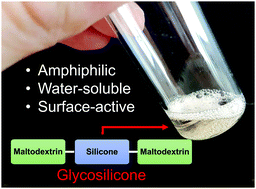Block-copolymeric maltodextrin-based amphiphilic glycosilicones as surface-active systems†
Abstract
Newly obtained amphiphilic glycosilicones are based on commercially available maltodextrins of various molecular weights (dextrose equivalent (DE) = 16.5–19.5 and 4–7) and hydride-terminated polydimethylsiloxane (Mw = 900). These carbohydrate polymers were synthesized via catalytic hydrosilylation employing Karstedt's catalyst, performed in benzene, between protected (by acetylation) and then modified (by allylation) maltodextrins with the hydride-terminated polydimethylsiloxane followed by deprotection. The block-copolymeric structure of the thus obtained glycosilicones was confirmed by 1H, 13C{1H}, and 29Si{1H} NMR spectroscopy. The carbohydrate polymers are soluble in water (<15 mg mL−1) and, in aqueous solutions, they form micelles, vesicles, and other aggregates with hydrodynamic radii spanning from 8 to 113 nm – as determined by dynamic light scattering, sedimentation experiments, and SEM. Titration calorimetry of glycosilicones based on maltodextrin demonstrates the critical micelle concentration of 13 mg mL−1 (ca. 10−3 mol L−1); these values are similar to those obtained for the commonly used alkylglucoside surfactants.



 Please wait while we load your content...
Please wait while we load your content...